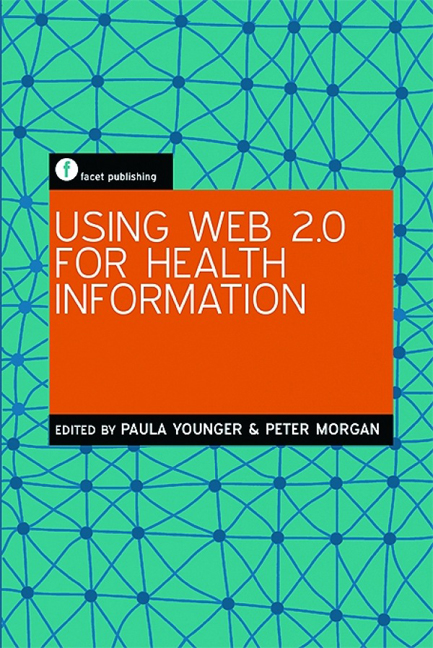Book contents
- Frontmatter
- Contents
- Preface
- Acknowledgements
- Contributors
- Glossary
- Introduction
- Part 1 The basics
- Part 2 Web 2.0 and the implications for health information
- Part 3 Web applications in health information provision: some practical examples
- 9 Web 2.0 in health libraries
- 10 RSS (Really Simple Syndication): helping faculty and residents stay up to date
- 11 Using mashups in health information provision
- 12 Twitter in a hospital library
- 13 Using Web 2.0 to facilitate staff development
- Part 4 The future
- Index
9 - Web 2.0 in health libraries
from Part 3 - Web applications in health information provision: some practical examples
Published online by Cambridge University Press: 08 June 2018
- Frontmatter
- Contents
- Preface
- Acknowledgements
- Contributors
- Glossary
- Introduction
- Part 1 The basics
- Part 2 Web 2.0 and the implications for health information
- Part 3 Web applications in health information provision: some practical examples
- 9 Web 2.0 in health libraries
- 10 RSS (Really Simple Syndication): helping faculty and residents stay up to date
- 11 Using mashups in health information provision
- 12 Twitter in a hospital library
- 13 Using Web 2.0 to facilitate staff development
- Part 4 The future
- Index
Summary
Introduction
Web 2.0 technologies are becoming increasingly important in healthcare (Randeree, 2009; Van De Belt et al., 2010). Health librarians and information professionals need to keep up to date with developments in technology and the latest in health information in order to support evidence-based healthcare (Sackett et al., 1996). In this chapter I will draw on specific examples of how health librarians make use of Web 2.0 technologies to enhance their work and support clinicians in their clinical practice, using my own experience as a Clinical Librarian at University Hospitals of Leicester (UHL) NHS Trust. I will present three case studies on different applications for Web 2.0 technology: the Clinical Librarian Blog; the UHL Writing Club wiki; and the Clinical Librarian Podcast; as well as the rationale for their use.
UHL NHS Trust is a large teaching hospital trust, with over 11,000 staff providing acute and secondary care to Leicester, Leicestershire and Rutland. There are three main hospital sites within the city: the Glenfield Hospital, Leicester General Hospital and the Leicester Royal Infirmary. UHL NHS Trust has two Trust-owned libraries, based at the Glenfield and Leicester General hospitals, and provides remote services to the Leicester Royal Infirmary, although there is a physical library there offering basic loan services to NHS staff.
The Clinical Librarian Service at UHL NHS Trust has been in place since its pilot in 2000, and has expanded over the years to three full-time Clinical Librarians (CLs) providing a service to most of the main clinical and corporate areas within the Trust. Two CLs support the clinical teams: Accident and Emergency; Anaesthesia; Cancer; Cardiorespiratory; Children's Services; Diabetes; Gastroenterology; Musculoskeletal; Renal and Transplant Services; Stroke; Surgery; and Women's, Perinatal and Sexual Health. The third CL supports corporate areas, including audit and infection control. This means that the CL maintains close contact with the teams, often attending ward rounds and case meetings so as to be best placed to understand the context of the question and the need for information, as well as acting as a prompt for the Trust staff to ask for a search of the evidence base to support their decisions.
- Type
- Chapter
- Information
- Using Web 2.0 for Health Information , pp. 95 - 106Publisher: FacetPrint publication year: 2011



